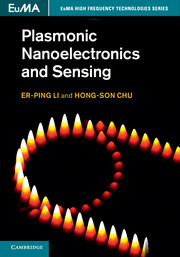Book contents
- Frontmatter
- Contents
- List of contributors
- Preface
- 1 Fundamentals of plasmonics
- 2 Plasmonic properties of metal nanostructures
- 3 Frequency-domain methods for modeling plasmonics
- 4 Time-domain simulation for plasmonic devices
- 5 Passive plasmonic waveguide-based devices
- 6 Silicon-based active plasmonic devices for on-chip integration
- 7 Plasmonic biosensing devices and systems
- Index
Preface
Published online by Cambridge University Press: 05 March 2014
- Frontmatter
- Contents
- List of contributors
- Preface
- 1 Fundamentals of plasmonics
- 2 Plasmonic properties of metal nanostructures
- 3 Frequency-domain methods for modeling plasmonics
- 4 Time-domain simulation for plasmonic devices
- 5 Passive plasmonic waveguide-based devices
- 6 Silicon-based active plasmonic devices for on-chip integration
- 7 Plasmonic biosensing devices and systems
- Index
Summary
Data communication and information processing are driving the rapid development of ultra-high speed and ultra-compactness in nano-photo-electronic integration. Plasmonics technology has in recent years demonstrated the promise to overcome the size mismatch between microscale photonic and nanoscale electronic integration, and it likely will be crucial for the next generation of on-chip optical nano-interconnects, enabling the deployment of small-footprint and low-energy integrated circuitry.
The phenomenon of surface plasmons was first observed in the Lycurgus cup, which is a Roman glass cage cup in the British Museum, London, UK. This special cup is made of a dichroic glass that shows a different color depending on the condition of illumination. Specifically, in daylight, the cup appears to have a green color, which means that light is being reflected from the cup; however, when a light is shone into the cup and transmitted through the glass, it appears to have a red color. Today, we know that this fascinating behavior is due to nanoscopic-scale gold and silver particles embedded in the glass. However, it took 1500 years and doubtless countless fantastic interpretations for a plausible explanation to emerge. In the last few decades, the phenomenon of surface plasmons has been extensively studied both theoretically and experimentally, and there have been attempts to use it for various applications ranging from solar-cell energy and sensing to nanophotonic devices.
- Type
- Chapter
- Information
- Plasmonic Nanoelectronics and Sensing , pp. xi - xiiPublisher: Cambridge University PressPrint publication year: 2014



